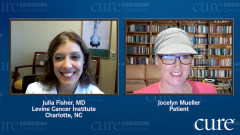
HER2-positive Breast Cancer: Pre-operative Therapies
Dr. Julie Fisher, an expert oncologist, describes the range of treatment options for HER2-positive breast cancer in the pre-operative setting.
Episodes in this series

Julie Fisher, MD: I’d like to move into what the typical treatment pathways are for patients with HER2-positive breast cancer. As your sister alluded to, we tend to have a fairly low threshold for reaching for chemotherapy, again, in conjunction with these HER2-targeted drugs. Our reason for that is the knowledge that HER2-positive breast cancer without treatment wants to be an aggressive player. Our means of combating that is typically going to be chemotherapy combined with HER2-targeted treatments, and we do find ourselves reaching for those, frankly, even for tumors that are fairly small. For somebody who has not undergone surgery and is presenting with a HER2-amplified breast cancer, and in your case it was palpable, we know we’re going to be utilizing chemotherapy. We know we’re going to be utilizing some flavor of HER2-targeted treatment. The initial question is, should we start with preoperative chemotherapy, or should we start with surgery and follow up with postoperative chemotherapy?
There are different things that inform that decision-making. Sometimes if a tumor is very small, isn’t palpable, and we are very confident it doesn’t involve the lymph nodes, we might start with an upfront surgical approach. However, typically when we’re facing a larger palpable area, we often want to go ahead and start with chemotherapy/HER2-targeted therapy first. Our rationale behind that is multifold. First, starting off with treatment allows us the possibility of shrinking or downstaging the disease; it offers us the opportunity to render the tumor in the breast smaller. For somebody who has suspected or documented lymph node involvement, it offers us the opportunity to treat, or hopefully, even eradicate some of that disease in the lymph node. That can in turn translate into a less aggressive surgery, which is a good thing. Probably as important if not more important to me as the medical oncologist is the knowledge that when we start with preoperative chemotherapy, we are able to then determine, well, how well did this chemotherapy work? The way we’re able to determine that is we get to see what the effect was in the breast when the surgeon takes the patient to the operating room.
Sometimes chemotherapy and preoperative treatments achieve what we call a complete response. The surgeon goes in, goes to the clip or the tag that was left to mark the spot, removes it, and finds that all disease has been eradicated in the breast; the chemo has killed everything. That’s a complete response. Other times we get a partial response, which is also self-explanatory; the chemotherapy has killed off a lot of the cancer, not all of the cancer, and anything that’s left behind the surgeon removes. However, that complete versus partial response gives us a wealth of information about how well we expect the chemotherapy to work everywhere, and it then influences how we treat the cancer after surgery.
I keep talking about these mysterious HER2-targeted drugs; the first drug that came on the scene was trastuzumab. The main brand for that drug is Herceptin, and 2005 is when it was introduced. At the time of its introduction, it was being studied with administration over a 1-year period; we’re still primarily doing that. There have been some studies trying to look at 6 months versus 12 months of Herceptin. 12 months is still the standard in most cases, so we’re looking at a year’s worth of therapy. We’re going to be tailoring the postoperative treatment, which type of HER2-targeted therapy we use, to the type of response we saw to the preoperative chemotherapy. Preoperatively, there are different regimens that can be used. The original studies that demonstrated the benefit of Herceptin used a backbone of chemotherapy that included a drug called Adriamycin [doxorubicin]. It is still a good regimen but at our center, we tend to shy away from that in most cases. Regimens that have a backbone of taxanes, drugs like Taxol [paclitaxel] and Taxotere [docetaxel] are incredibly effective and have less cardiac toxicity than the combination that uses the Adriamycin.
We talk about, what is the preoperative regimen going to be? Again, the one that I tend to reach for most and the one that you’re receiving is a program of four different drugs: that’s 2 chemotherapy drugs coupled with 2 HER2-targeted drugs, our old friend Herceptin and its cousin drug Perjeta [pertuzumab]. We’re going to amass those 4 drugs together, and it’s given every 3 weeks for a total of 6 preoperative treatments. We’re seeing each other after each treatment for 2 big reasons. One is for me to see how you’re feeling and assess what kind of side effects you might be experiencing, and try to intervene with any assistance I can offer depending on what’s going on. Two is to perform a physical examination to make sure that the treatment is doing what we are hoping and expecting that it will do. Again, most cancers are going to respond to chemotherapy; it is uncommon for cancer to grow or progress on treatment. It does happen, and when it does happen, we need to pivot and shift gears quickly. It’s important to have that exam be part of the program.
Transcript edited for clarity.

